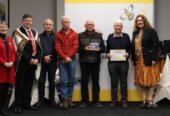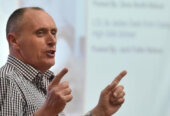
Would a third bridge be needed with coastal ship replacements?

By Peter Carr
On Tuesday of this week, I had reason to drive over the Kaimai Hill twice – on a very warm and muggy day. And along with all the car drivers who are entitled to a road speed of 100 Km per hour I struggled behind a huge queue of very large trucks most of which would have been destined for or from the Port of Tauranga. Or working with Tauranga-based industries where the base product, certainly of imports, would have crossed the wharves.
Include in that the large number of crawling logging trucks labouring up the steep slopes, albeit being well ordered in the way they use the long truck passing bays.
The reason I bring this to your attention is that just about every one of those trucks would have passed through – or very close to – Cambridge. And for that matter Te Awamutu too. And those with the King Country and Taranaki at one end of their journey would be very much the beneficiaries of a third bridge at Cambridge. However, it can also be argued that those trucks will, within a few years, be able to join SH1 near Tamahere when the planned Southern Link bends its way under the southern end of Hamilton.
Coincidental with this was that this evening I took part – or at least watched and listened to – a very interesting webinar on my computer screen. The three presenters (two of whom I have worked with) put the case that increasing container ship sizes will drive the ports of both Auckland and Tauranga to reach their limits within 10 years. They argued the sheer size of the required ships (hitherto never seen in this country) will very much slow down the ship exchange rate due to the height of the stacked containers, the width of the ships underpinned by the current pavement strength of the wharf surface that will not support what we may wish to call ‘super’ cranes.
The webinar postulated that both ports should be regarded – in container terms – of having limited lifespans. And that both could – and perhaps should – be replaced with a whole new structure in the Manukau Harbour. That siting will markedly reduce ship steaming times and also materially shorten the transit time of container vessels to points south. That would alleviate the over-utilised roading system, bringing into question the need for replacement rail ferries.
Back here on the local scene I have not seen the traffic flow statistics of truck traffic in the vicinity of the eastern end of Kaipaki Road. The Waipā District Council will certainly have that measure and the information is publicly available on the web.
But, and not to deeply disappoint the proponents for a third bridge, would this become necessary if the enormous weight of trucks that currently stagger/roar along Pope Terrace were replaced by coastal ships? Incidentally the webinar also neatly packaged a great saving in carbon-based fuel emissions per tonne/kilometre.
Opinion pieces are only one person’s thoughts or observations – perhaps sometimes tongue-in-cheek to kick-start a conversation or a worthwhile debate.
Anything to get away from the dribble we have been hearing about traffic lights (of the non-roading variety)!









